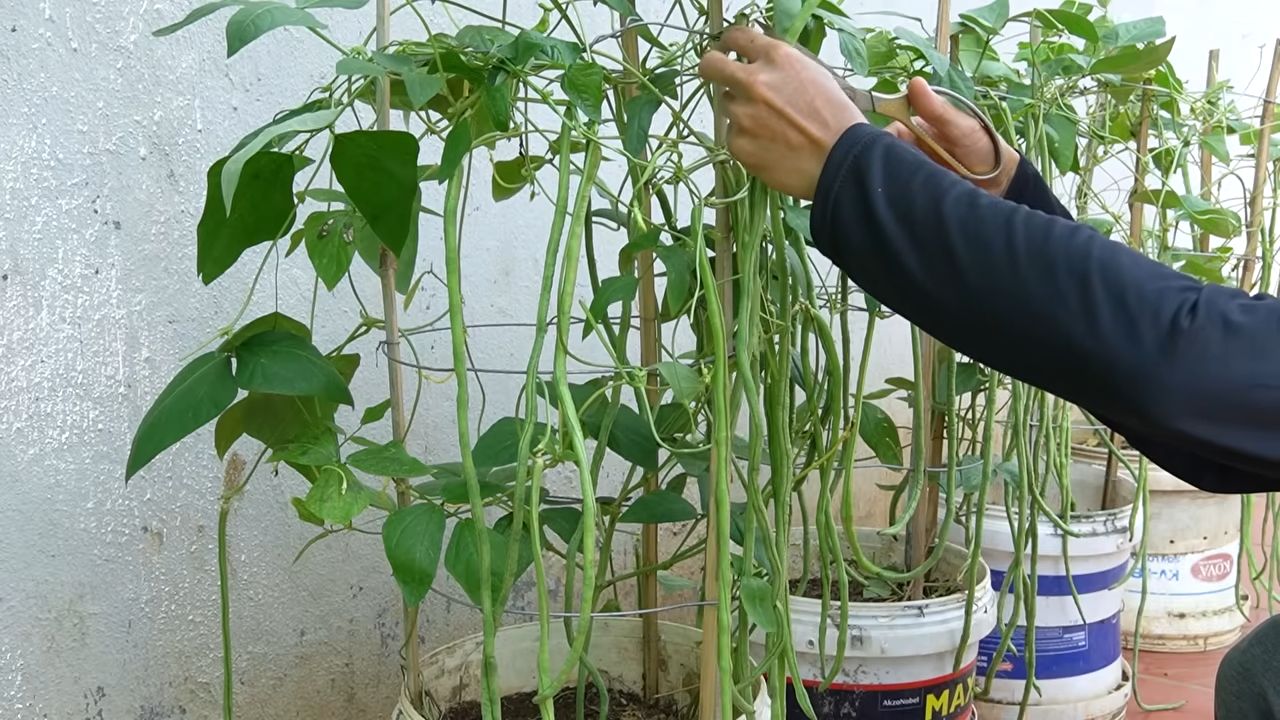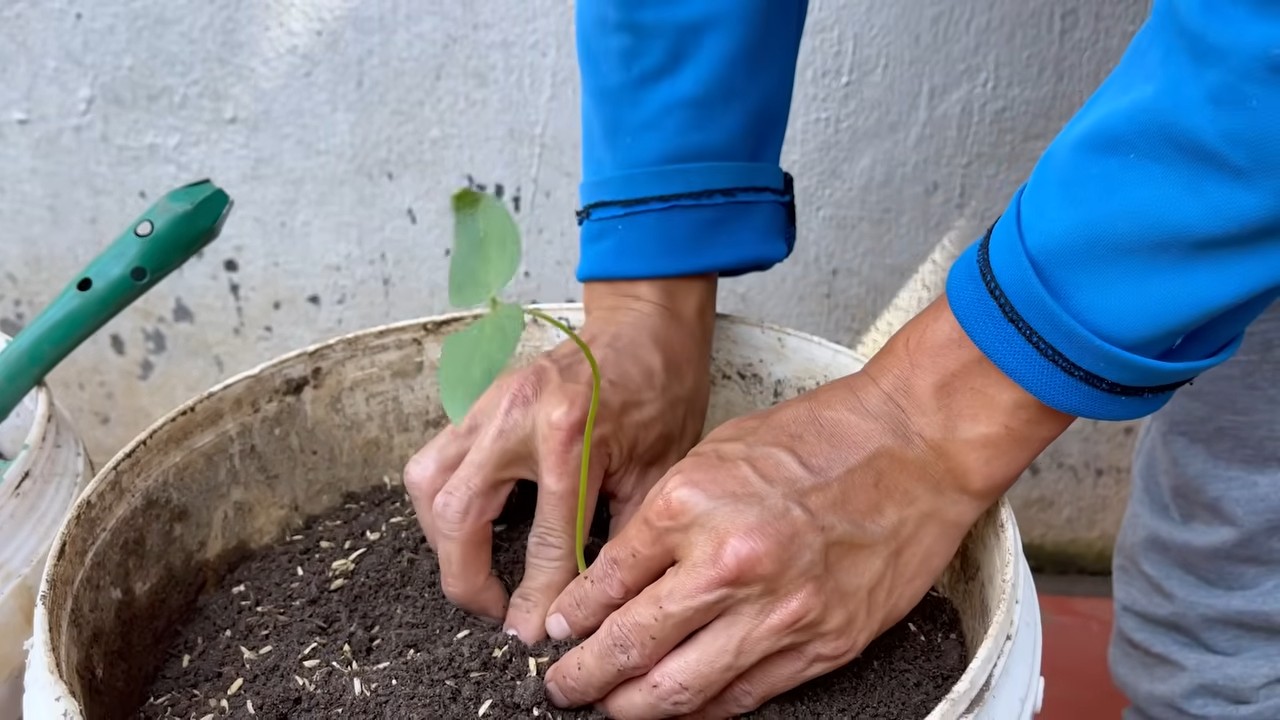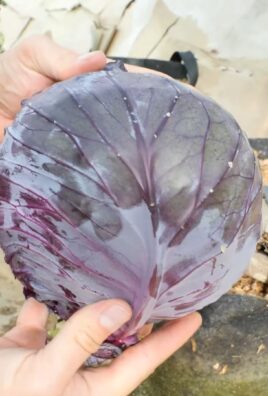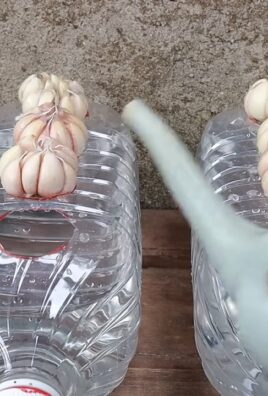Grow bigger watermelons than you ever thought possible! Imagine the look on your neighbor’s faces when they see the colossal fruit bursting from your garden. Forget those tiny, grocery store watermelons – we’re talking prize-winning, picnic-stopping giants! This isn’t just about size; it’s about bragging rights, delicious summer feasts, and the pure joy of nurturing something extraordinary.
For centuries, watermelons have been a symbol of summer abundance and communal gatherings. From ancient Egyptian tombs where they were placed as provisions for the afterlife, to the vibrant watermelon festivals celebrated across the American South, this fruit holds a special place in our hearts and traditions. But let’s be honest, who wouldn’t want to take that tradition to the next level with a truly impressive specimen?
Many gardeners struggle to achieve watermelon greatness. They pour their heart and soul into their plants, only to be disappointed by small, lackluster fruits. That’s where these DIY tricks and hacks come in! I’m going to share simple, yet effective techniques that will help you grow bigger watermelons, even if you’re a beginner. These aren’t complicated methods requiring expensive equipment; they’re practical tips you can implement right now to maximize your yield and impress everyone with your gardening prowess. Get ready to unlock the secrets to watermelon success and enjoy the sweetest, juiciest, and biggest watermelons you’ve ever tasted!

Wassermelonen-Wachstums-Hack: So erntest du riesige Früchte!
Hey Leute, ich liebe Wassermelonen! Und ich liebe es noch mehr, riesige, saftige Wassermelonen aus meinem eigenen Garten zu ernten. Über die Jahre habe ich einige Tricks und Kniffe gelernt, die wirklich einen Unterschied machen. Ich teile heute meine bewährte Methode mit euch, damit auch ihr bald beeindruckende Wassermelonen ernten könnt. Keine Angst, es ist einfacher als es aussieht!
Die Grundlagen: Was Wassermelonen zum Wachsen brauchen
Bevor wir ins Detail gehen, ist es wichtig zu verstehen, was Wassermelonen wirklich brauchen, um zu gedeihen. Das sind die wichtigsten Faktoren:
* Sonne, Sonne, Sonne: Wassermelonen sind Sonnenanbeter. Sie brauchen mindestens 6-8 Stunden direkte Sonneneinstrahlung pro Tag. Je mehr, desto besser!
* Nährstoffreicher Boden: Wassermelonen sind Starkzehrer. Sie brauchen einen Boden, der reich an organischen Stoffen und Nährstoffen ist.
* Ausreichend Wasser: Wassermelonen brauchen viel Wasser, besonders während der Fruchtbildung.
* Platz zum Wachsen: Wassermelonenranken können sich weit ausbreiten. Stelle sicher, dass sie genügend Platz haben.
* Bestäubung: Wassermelonen brauchen Bienen und andere Bestäuber, um Früchte zu bilden.
Schritt-für-Schritt-Anleitung für riesige Wassermelonen
Hier ist meine detaillierte Anleitung, wie du deine Wassermelonen zum Riesenwachstum anregen kannst:
1. Die richtige Sorte wählen
Nicht alle Wassermelonen sind gleich. Einige Sorten sind von Natur aus größer als andere. Hier sind einige Sorten, die für ihre Größe bekannt sind:
* Carolina Cross: Diese Sorte ist berühmt für ihre riesigen Früchte. Sie können über 90 kg wiegen!
* Moon and Stars: Eine wunderschöne Sorte mit dunklen Früchten und gelben “Mond”- und “Stern”-Flecken. Sie können auch sehr groß werden.
* Black Diamond: Eine klassische Sorte mit dunkler Schale und rotem Fruchtfleisch. Sie ist bekannt für ihre Größe und ihren Geschmack.
Wähle eine Sorte, die für dein Klima und deine Bodenbedingungen geeignet ist. Informiere dich am besten im Fachhandel oder online.
2. Den Boden vorbereiten
Ein guter Boden ist das A und O für gesunde und große Wassermelonen. So bereitest du ihn vor:
1. Boden testen: Beginne mit einem Bodentest, um den pH-Wert und den Nährstoffgehalt zu bestimmen. Wassermelonen bevorzugen einen leicht sauren Boden mit einem pH-Wert zwischen 6,0 und 6,8.
2. Bodenverbesserung: Arbeite reichlich organische Stoffe in den Boden ein, z. B. Kompost, gut verrotteten Mist oder Laub. Das verbessert die Drainage, die Belüftung und den Nährstoffgehalt.
3. Düngen: Füge einen ausgewogenen Dünger hinzu, der reich an Stickstoff, Phosphor und Kalium ist. Ich verwende gerne einen Langzeitdünger, der die Nährstoffe langsam freisetzt.
4. Hügel anlegen: Lege Hügel an, um die Drainage zu verbessern und den Boden schneller zu erwärmen. Die Hügel sollten etwa 30 cm hoch und 60 cm breit sein.
3. Die Aussaat oder das Pflanzen
Du kannst Wassermelonen entweder direkt aussäen oder Jungpflanzen kaufen. Ich bevorzuge es, Jungpflanzen zu kaufen, da sie einen Vorsprung haben.
1. Aussaat: Wenn du direkt aussäen möchtest, säe die Samen etwa 2-3 cm tief in die Hügel. Halte einen Abstand von etwa 90-120 cm zwischen den Pflanzen ein.
2. Pflanzen: Wenn du Jungpflanzen verwendest, pflanze sie in die Hügel. Achte darauf, dass der Wurzelballen vollständig mit Erde bedeckt ist. Halte auch hier einen Abstand von etwa 90-120 cm zwischen den Pflanzen ein.
3. Gießen: Gieße die Pflanzen nach dem Pflanzen gründlich.
4. Die richtige Bewässerung
Wassermelonen brauchen viel Wasser, besonders während der Fruchtbildung.
1. Regelmäßig gießen: Gieße die Pflanzen regelmäßig, besonders bei trockenem Wetter. Der Boden sollte immer feucht, aber nicht durchnässt sein.
2. Tief gießen: Gieße tief, damit das Wasser die Wurzeln erreicht.
3. Tröpfchenbewässerung: Eine Tröpfchenbewässerung ist ideal, da sie das Wasser direkt zu den Wurzeln liefert und die Blätter trocken hält. Das hilft, Krankheiten vorzubeugen.
4. Gießmenge reduzieren: Reduziere die Gießmenge, wenn die Früchte reif werden. Das hilft, den Zuckergehalt zu erhöhen.
5. Die richtige Düngung
Wassermelonen brauchen während der Wachstumsphase regelmäßig Dünger.
1. Stickstoffbetonter Dünger: Verwende in der frühen Wachstumsphase einen stickstoffbetonten Dünger, um das Blattwachstum zu fördern.
2. Phosphor- und kaliumbetonter Dünger: Wenn die Pflanzen zu blühen beginnen, wechsle zu einem phosphor- und kaliumbetonten Dünger, um die Fruchtbildung zu fördern.
3. Regelmäßig düngen: Dünge die Pflanzen alle 2-3 Wochen mit einem Flüssigdünger.
4. Blattdüngung: Eine Blattdüngung mit Seetangextrakt kann auch hilfreich sein, um die Pflanzen mit zusätzlichen Nährstoffen zu versorgen.
6. Bestäubung unterstützen
Wassermelonen brauchen Bienen und andere Bestäuber, um Früchte zu bilden.
1. Bienenfreundliche Pflanzen: Pflanze bienenfreundliche Pflanzen in der Nähe deiner Wassermelonen, um Bestäuber anzulocken.
2. Handbestäubung: Wenn du nicht genügend Bienen hast, kannst du die Blüten auch von Hand bestäuben. Trage dazu mit einem kleinen Pinsel Pollen von den männlichen Blüten auf die weiblichen Blüten auf. Die weiblichen Blüten erkennst du an dem kleinen Fruchtansatz direkt unter der Blüte.
3. Insektizide vermeiden: Vermeide den Einsatz von Insektiziden, da sie Bienen und andere Bestäuber schädigen können.
7. Ausgeizen und Beschneiden
Das Ausgeizen und Beschneiden von Wassermelonenranken kann helfen, die Fruchtgröße zu erhöhen.
1. Ausgeizen: Entferne Seitentriebe, die aus den Blattachseln wachsen. Das lenkt die Energie der Pflanze auf die Hauptranken und die Früchte.
2. Beschneiden: Beschneide die Ranken, nachdem sich einige Früchte gebildet haben. Entferne alle Blüten und kleinen Früchte, die sich nach den ersten 2-3 Früchten bilden. Das hilft, die Energie der Pflanze auf die verbleibenden Früchte zu konzentrieren.
3. Blätter entfernen: Entferne gelbe oder beschädigte Blätter, um die Luftzirkulation zu verbessern und Krankheiten vorzubeugen.
8. Fruchtpflege
Die richtige Fruchtpflege ist entscheidend für das Wachstum großer Wassermelonen.
1. Fruchtunterlage: Lege eine Unterlage unter die Früchte, um sie vor Bodenkontakt und Fäulnis zu schützen. Du kannst Stroh, Pappe oder spezielle Fruchtunterlagen verwenden.
2. Drehen: Drehe die Früchte regelmäßig, damit sie gleichmäßig besonnt werden.
3. Sonnenschutz: Schütze die Früchte vor direkter Sonneneinstrahlung, besonders bei extremer Hitze. Du kannst sie mit einem Tuch oder einem Sonnenschirm abdecken.
9. Schädlinge und Krankheiten bekämpfen
Wassermelonen können von verschiedenen Schädlingen und Krankheiten befallen werden.
1. Regelmäßige Kontrolle: Kontrolliere die Pflanzen regelmäßig auf Schädlinge und Krankheiten.
2. Natürliche Schädlingsbekämpfung: Verwende natürliche Schädlingsbekämpfungsmittel wie Neemöl oder Insektizidseife.
3. Krankheitsvorbeugung: Sorge für eine gute Luft

Conclusion
So, there you have it! Mastering the art of growing bigger watermelons isn’t about magic; it’s about understanding the plant’s needs and providing the right environment and care. From strategic pruning and diligent watering to the crucial step of hand-pollination when necessary, each technique contributes significantly to the final size and quality of your harvest. We’ve explored proven methods to maximize your watermelon’s growth potential, ensuring you’re not just growing watermelons, but cultivating giants!
This isn’t just another gardening tip; it’s a pathway to experiencing the immense satisfaction of nurturing a plant from seed to a fruit that’s the envy of the neighborhood. Imagine the look on your friends’ faces when you present them with a watermelon that’s almost too big to carry! The taste of homegrown, juicy sweetness, amplified by its impressive size, is an experience that store-bought watermelons simply can’t replicate.
Don’t be intimidated by the process. While it requires attention and effort, the rewards are well worth it. Think of it as a learning journey, an opportunity to connect with nature and develop your gardening skills. Even if your first attempt doesn’t yield a record-breaking watermelon, you’ll gain valuable knowledge and experience that will benefit future harvests.
Consider these variations to further personalize your watermelon growing journey:
* Experiment with different watermelon varieties: Some varieties are naturally predisposed to grow larger than others. Research and choose varieties known for their size, such as ‘Carolina Cross’ or ‘Black Diamond.’
* Soil amendments: While we’ve emphasized the importance of well-draining soil, consider adding specific amendments like bone meal or Epsom salts to provide extra phosphorus and magnesium, which are crucial for fruit development. Always test your soil first to determine its specific needs.
* Companion planting: Explore companion planting strategies to deter pests and attract beneficial insects. Marigolds, for example, can help repel nematodes, while dill attracts pollinators.
* Grafting: For the truly ambitious, consider grafting your watermelon onto a more vigorous rootstock, such as squash. This can significantly boost the plant’s growth and disease resistance.
We strongly encourage you to try these DIY tricks for growing bigger watermelons. The process is rewarding, the results are delicious, and the knowledge you gain is invaluable. Remember to document your progress, take photos, and share your experiences with us! We’d love to hear about your successes, challenges, and any unique techniques you discover along the way. Share your photos and stories on our social media pages using #GiantWatermelonChallenge. Let’s cultivate a community of watermelon enthusiasts and learn from each other’s experiences. Happy growing!
Frequently Asked Questions (FAQ)
What is the most crucial factor in growing bigger watermelons?
The most crucial factor is a combination of things working together. It’s not just one single element, but rather a holistic approach. This includes providing the watermelon plant with nutrient-rich, well-draining soil, consistent and adequate watering, strategic pruning to focus the plant’s energy on fewer fruits, and ensuring proper pollination. Sunlight is also critical; watermelons need at least 6-8 hours of direct sunlight per day. Neglecting any of these aspects can significantly hinder the watermelon’s growth potential.
How often should I water my watermelon plants?
Watermelon plants need consistent moisture, especially during fruit development. Aim to water deeply 2-3 times per week, providing enough water to soak the soil down to a depth of at least 6 inches. The frequency may need to be adjusted based on weather conditions and soil type. Check the soil moisture regularly; if the top inch feels dry, it’s time to water. Avoid overwatering, as this can lead to root rot. Drip irrigation is an excellent method for delivering water directly to the roots, minimizing water waste and reducing the risk of fungal diseases.
When should I start pruning my watermelon plants?
Start pruning your watermelon plants once they have developed several healthy vines and the first flowers begin to appear. The goal of pruning is to direct the plant’s energy towards developing a few strong, healthy fruits rather than spreading it across numerous smaller ones. Remove any suckers (small shoots that grow from the base of the plant) and any non-fruit-bearing vines. Once you have a few developing watermelons, you can also prune away some of the leaves surrounding the fruits to improve air circulation and sunlight exposure.
How do I know when my watermelon is ripe?
Determining watermelon ripeness can be tricky, but there are several indicators to look for. The most reliable sign is the “ground spot,” the area where the watermelon rests on the ground. When the watermelon is ripe, this spot will turn from white to a creamy yellow color. Other indicators include a dull thud when you tap the watermelon (a ripe watermelon will sound hollow), a dried tendril closest to the fruit, and a slight give when you press on the blossom end (the opposite end from the stem).
What kind of fertilizer should I use for watermelons?
Watermelons benefit from a balanced fertilizer during the early stages of growth, followed by a fertilizer higher in phosphorus and potassium during fruit development. A fertilizer with an NPK ratio of 10-10-10 is suitable for initial growth, while a fertilizer with an NPK ratio of 5-10-10 or 6-12-12 is better for fruit development. Avoid using fertilizers that are too high in nitrogen, as this can promote excessive vine growth at the expense of fruit production. Organic options like compost tea and bone meal are also excellent choices. Always follow the instructions on the fertilizer label and avoid over-fertilizing.
My watermelon flowers are falling off. What’s happening?
This is often due to a lack of pollination. Watermelons have separate male and female flowers, and the female flowers need to be pollinated by bees or other pollinators in order to develop into fruit. If you’re not seeing many bees in your garden, you may need to hand-pollinate the flowers. To do this, use a small paintbrush to transfer pollen from the male flowers to the female flowers. Identify the female flowers by the small, immature watermelon at the base of the flower. Pollinate in the morning, when the pollen is most viable.
How can I protect my watermelons from pests and diseases?
Several pests and diseases can affect watermelons, including aphids, squash bugs, vine borers, and fungal diseases like powdery mildew. Regularly inspect your plants for signs of pests or diseases and take action promptly. Use organic pest control methods like insecticidal soap or neem oil to control aphids and squash bugs. Wrap the base of the vines with aluminum foil to deter vine borers. Ensure good air circulation around the plants to prevent fungal diseases. Consider using a copper fungicide if powdery mildew becomes a problem. Crop rotation and choosing disease-resistant varieties can also help prevent problems.
Can I grow watermelons in containers?
Yes, you can grow watermelons in containers, but you’ll need a large container (at least 20 gallons) and a dwarf or bush variety of watermelon. Ensure the container has good drainage and use a high-quality potting mix. Water container-grown watermelons more frequently than those grown in the ground, as the soil in containers tends to dry out more quickly. You may also need to provide additional support for the vines as they grow.
How much space do watermelon plants need?
Watermelon plants need a significant amount of space to grow. Vining varieties typically require at least 6-8 feet of space between plants, while bush varieties need about 3-4 feet. If you’re growing watermelons in rows, space the rows 8-10 feet apart. Proper spacing is essential for good air circulation and sunlight exposure, which helps prevent diseases and promotes healthy growth.
What are some good companion plants for watermelons?
Good companion plants for watermelons include marigolds (which repel nematodes), nasturtiums (which attract beneficial insects), radishes (which deter squash vine borers), and herbs like oregano and basil (which repel various pests). Avoid planting watermelons near potatoes or other members of the nightshade family, as they can compete for nutrients and attract similar pests and diseases.




Leave a Comment